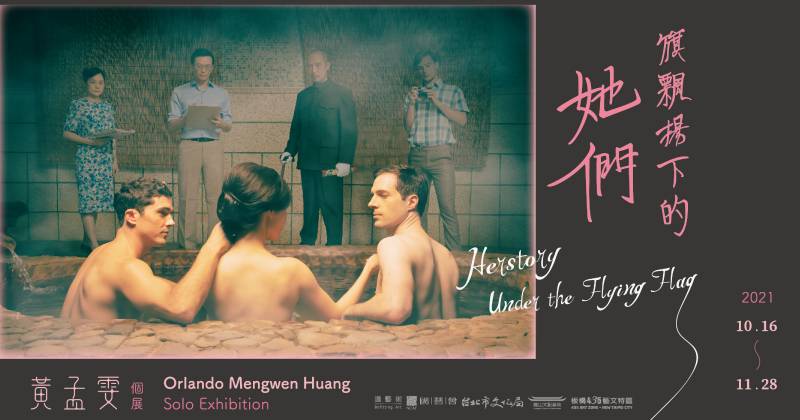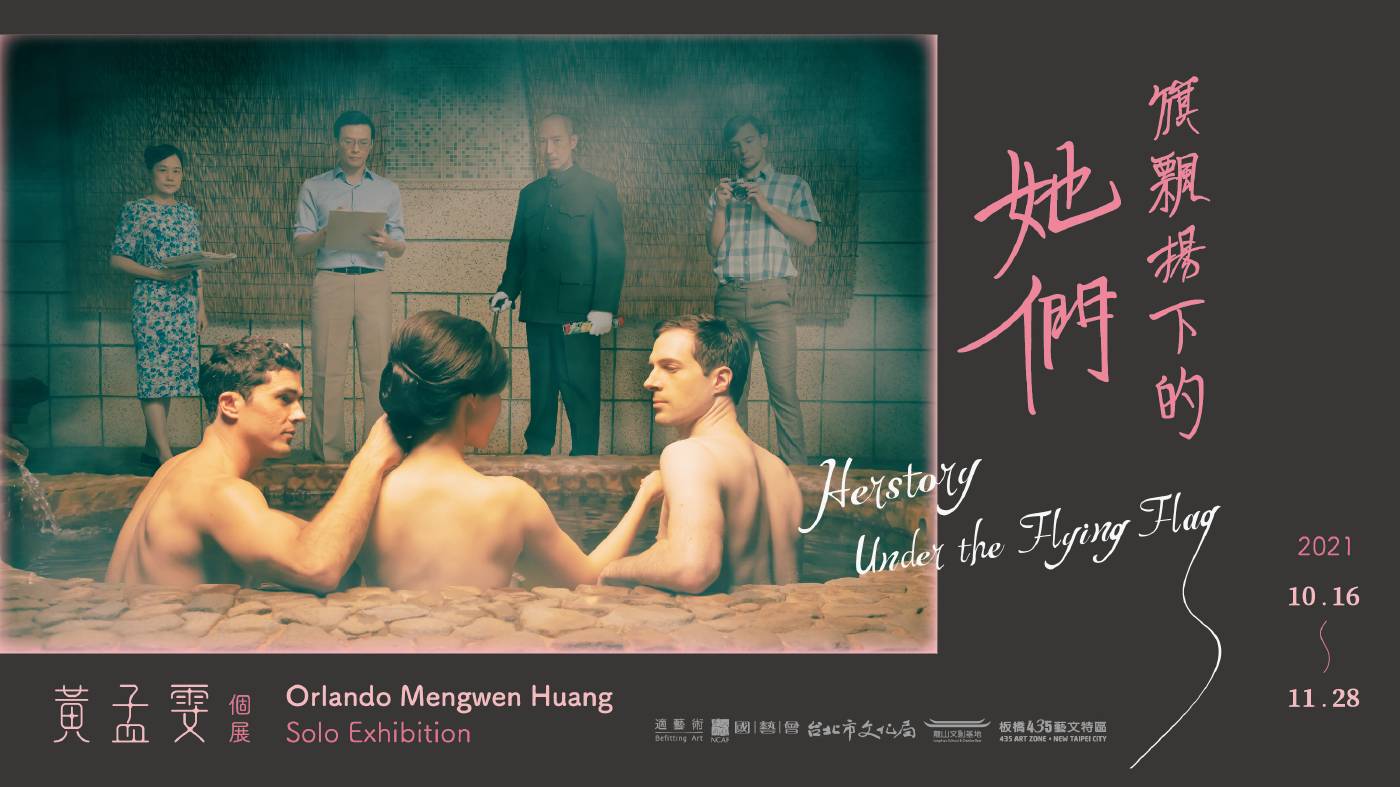適藝術 Befitting Art
【「旗飄揚下的她們」―黃孟雯個展】「Herstory under the flying flag」―Orlando Mengwen Huang Solo Exhibition

-
展期
日期:2021-10-16 ~ 2021-11-28
-
地點
台北市西園路一段145號B2龍山文創基地
-
相關連結
-
參展藝術家
黃孟雯
-
「旗飄揚下的她們」―黃孟雯個展
策展人|邱柏廷 楊雅翔
展覽日期|2021.10.16-11.28
展覽地點|適藝術 台北市西園路一段145號B2龍山文創基地
開放時間|週二至週日AM11:00~PM7:00
●主題座談
場次一 2021.10.31 PM2:30
中山大學社會學系陳美華教授將講述台灣性工作合法化的現況
陳美華、黃孟雯
場次二2021.11.06 PM2:30
紀實攝影黃子明老師將聊聊關於「慰安婦」拍攝計畫的議題與經驗
黃子明、黃孟雯
-----------------------------------
●旗飄揚下的她們
「她們」有許多稱呼,遊女、藝妓、「慰安婦」、侍應生、女服務生、茶室女、酒家小姐、酒吧女、公娼等,不同的時期她們以不同的身分出現,配合著那個時代、那個單位、那個場所。她們的工作內容相似,隨著每個時代每個身分會有不同的工作方式,身體的親密關係是她們工作的重點。
人們印象中的「她們」總是在霓虹閃閃的煙花界,甚少知道「她們」在島嶼的歷史縫隙中默默付出她們的溫柔。在台灣蜿蜒經歷了殖民、二戰、戰後、冷戰,直至經濟奇蹟的近代史中,她們以身體勞動支撐自己,或成為家庭的支柱,配合國家政策成為國家動員的一份子,執辦國家交給「她們」的任務。然而,她們的身體勞動被國族視為不光彩的過去,為了國家的良好形象,「她們」成為被遺忘的記憶。其實,「她們」一直存在於台灣歷史的角落,主流歷史的邊緣。
「旗飄揚下的她們」由島嶼歷史中的「她」思考親密關係勞動者如何成為國家動員的一環,日治時代公娼制度成為帝國擴張領土的政策之一;二戰期間遭受日軍性暴力的「慰安婦」;戰後國民政府來台反共復國旗幟下隨各地駐軍的軍中特約茶室,或是敬軍愛國的酒家小姐;與冷戰期間,陪伴在台美國大兵的酒吧女。
由之延伸的是台灣百年來,當女性身體成為國家機器的資源,國家如何動員「她們」為國家效力,從日治到冷戰後。此計畫試圖在這近百年不同時空卻相似的生命政治之間,串連起歷史的連續性,此連續性背後蘊含著國家機器中的男性中心思維,結合國家權力機制,體現在這些職業女人們的生命中。而她僅能以命運理解自己的處境。她們曾有故事、曾有名字,而如今我們僅僅只能以「她」帶過。這是個關於這些職業女人們的故事,被污名化的女人們的故事。
她們與我。性別與近代史是我藝術計畫所關注的,當我以「性別」的視角探勘這個島嶼的歷史,不斷在各個時期、各種資料中,見到她們稀微的身影,我開始索尋她們的足跡,尋找她們的過去,竟發現「她們」與台灣這個島嶼的政權更迭、經濟脈絡息息相關,在這難以啟齒的勞苦職業背後是關於國家、戰爭與權力。我思考若是以「她們」的視角來拼湊歷史,那會是一個怎樣的台灣現代史故事。
當「她們」以身體溫柔的懷抱著這汙名的工作,默默地承受台灣近代史的曲折與不堪銘印,本計畫以藝術之名回報她們的溫柔。在流動的電影影像與瞬間的攝影時刻中,藝術的召喚術,召喚逝去的集體記憶。她們的故事,就是我們的過去。
-----------------------------------
●藝術家介紹
黃孟雯,畢業於臺北藝術大學藝術跨域研究所、臺北大學社會研究所。透過田野檔案與社會學為方法,擅長以短篇電影、編導式攝影、錄像、裝置與書寫等為主要創作形式,關注台灣近代史中的性∕性別脈絡,藉以建構以女性∕酷兒為核心所述說的歷史視角,探討性工作與國家的邊緣史。
2018年至韓國光州Spaceppong駐村,於當地舉行駐村雙個展,開始反思亞洲近代史中的女性議題,探究女同性戀對於傳統性別文化的反叛,與社會性別異議者的生命能動性與處境。作品視覺多採豔麗的色彩,藉由強烈的轉化意象紛呈探問被遺忘與隱匿的真實,使創作成為歷史與記憶的回聲,以藝術的幻術貼近邊緣歷史與情感真實。
作品多次受邀參與海內外展覽與影展,如FASE阿根廷影像藝術節、阿根廷 VideoBardo 影像詩歌藝術節、日本Tokyo Lift-Off Film Festival、台灣國際酷兒影展、台南彩虹遊行性/別展覽、韓國Space One藝術空間、美國舊金山中華文化中心展出。
●本計畫獲國家文藝基金會109年第一期視覺藝術類補助
●本計畫獲台北市文化局110年度第二期視覺藝術類藝文補助
「Herstory under the flying flag」―Orlando Mengwen Huang Solo Exhibition
Exhibition dates|2021/10/16–2021/11/28 (Tue.-Sun. 11:00-19:00)
Exhibition venue|Befitting Art
These women had been called many names—yujo, geisha, comfort women, waitrees, waitresses, tea girls, liquor house girls, bar girls, licensed sex workers, and so on. They often showed up in the particular identity that a particular era, unit, or place needed them to be. Their ways of working might have changed for the era and their identity's needs, but these women's jobs were all similar—a major part of them was about sexual interactions.
People tend to have the impression that these women worked in the shiny sex-related entertainment industries. Little did they know about their silent dedication of their softness to the nation in the course of Taiwan's history. Throughout Taiwan's modern history, from Japan's colonization, World War II, the post-war period, the Cold War, to Taiwan's Economic Miracle, these women had been supported themselves or their families with their sex-related labor. They became a part of national mobilization whenever the policies demanded and they always carried out the tasks assigned to them by the government. Nevertheless, this sort of sex-related labor has been considered the disgraceful past of history by the nation. For a better image of the nation, these women had no choice but to be forgotten in people's memories. They had always existed on the periphery of Taiwan's so-called mainstream history.
Herstory Under the Flying Flag discusses how "these women", the sex-related laborers, became a part of the national mobilization in Taiwan's history. During the Japanese ruling period, the legal prostitution system had become one of Japan's territorial expansion policies. In the post-war period, there were the patriotic liquor house girls; and the military paradises set up by the anti-communist Nationalist government with a mission of national salvation. Last but not least, there were also bar girls that accompanied the U.S. soldiers in Taiwan during the Cold War.
We could not help but wonder how the nation mobilized these women and used their bodies as a resource of the state apparatus throughout Taiwan's modern history, from the Japanese ruling period to the post-Cold War period. This project attempts to connect all these similar biopolitics from different eras and illustrate a certain continuity in Taiwan's history. Behind this continuity is the male-centered thinking in the state apparatus which, in combination with the state power mechanism, was reflected in the lives of these professional women. And these women could merely believe that the situation they were in was just their fate. These women, who had names and stories to tell, can only be referred to as "she" nowadays. This is a story about these women, these stigmatized women.
These women and I. My art projects often focus on gender and modern history. When I went through Taiwan's history from the perspective of gender, I constantly saw traces of these women in all kinds of historical data. That was when I started to look for their footprints and figure out their past. To my surprise, these women's past was highly related to the regime shifts and economic contexts of Taiwan. Behind this so-called embarrassing job of theirs, it was also about the nation, the wars, and the power. I wondered what a story of Taiwan's modern history would be if it is told from these women's perspectives.
These women softly embraced their stigmatized job with their bodies, and silently took in all the shame as well as all the twists and turns in Taiwan's modern history. This project returns their tenderness in the name of art. With the dynamic images and the photographic moments captured, this project uses art as the spell to summon the long-forgotten collective memories. These women's stories are indeed our past. -
REFERENCE
